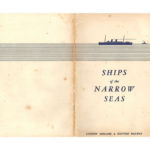Description
This is a very unusual publication, being compiled from reprints of unsigned “Railway Magazine” articles re-paginated from 1 to 48 in a smart cloth binding, with marbled end papers. There is no clue as to who commissioned it – perhaps the L&Y did as a PR gift for VIPs, in which case one would have expected a “With Compliments” note or similar. Possibly the “Railway Magazine” produced it as a result of external requests, it would hardly have been worth doing just for one copy though. My copy has the signature “J. C. Boustead” on the flyleaf, with later stamps and a label from the University of Salford Library.
The book begins with an excellent condensed history of the railway, then there are sections dealing with Principal Train Services, Goods Traffic, Locomotives and Rolling Stock, Electric Working, Steamship Services, Lancashire and Yorkshire Railway Docks, finally The Railway and its Advertising Department. All in all a very comprehensive selection of useful information.
The Lancashire and Yorkshire Railway (L&YR) was a major British railway company before the Grouping of 1923. It was formed in 1847 from an amalgamation of several existing railways and became the third-largest railway system based in the North of England, after the Midland and North Eastern Railways. These two, with the London & North Western, virtually surrounded its compact and intensively worked system, but for most of its history it managed to maintain good relations with all three. Indeed it merged with the LNWR a year before the Grouping, thus forming the largest constituent company of the London Midland & Scottish Railway.
The intensity of its service was reflected by the 1,650 locomotives which it owned it owned – it was by far the most densely trafficked system in the British Isles with more locomotives per mile than any other company and signal boxes every 3.5 miles. No two adjacent stations were more than 5.5 miles apart and its 1,904 passenger services occupied 57 pages in “Bradshaw” a number exceeded only by the Great Western, the LNWR and the Midland. It was the one of the first mainline railways to introduce electrification of some suburban routes, and it also ran steamship services across the Irish and North seas being at one time bigger shipowner than any other British railway company.
In common with most of the “old” companies the employees were fiercely loyal, perhaps in part due to the compact nature of the system. The chief officers were not mere faceless names printed on paper, but were well-known by sight, as they travelled around the railway carrying out their functions. My paternal grandfather, Robert Rankin served the L&Y in a variety of humble positions, ending long after normal retiring age as a night watchman on the LMS. He was a typical old Liverpool “Dicky Sam”, small in stature, garrulous, good humoured and full of curiosity concerning the world about him. Although lacking in formal education (he had run away to sea as a boy) he was full of tales and information about ships, the sea, and railways. One afternoon a week, he was lumbered with me while my mother, and her mother went off somewhere mysterious with Great Aunt Prudence. (I later discovered they were doing the rounds of spiritualist seances, as Prudence was trying to contact her intended, who vanished in the mud of the Somme in 1916). Sotalking all the time (he could never get a word in edgeways at home), Grandpa took me out to visit The Pier Head, travel on the Overhead Railway, visit an old crony on board a whaling factory ship (I can still remember the dreadful smell), and go to places of railway interest around the city, where he often knew someone. Thus my first visit to a signal box, and my only footplate trip on a “Pug”. Of course, being only about four years old, most of what he told me went straight over my head (I was a year or two older, before I realised the “Stephenson’s Rocket” he talked about was not some kind of big firework…) However, bits stuck in the back of my mind to come back to me in later life. The “Pug” incident marked one instance which only gradually made sense over the years. “Our boss `Snowball´” he said patting the “Pug” “ was a very clever gentleman who invented these, and he invented the electric railway from here to Southport and he built our works at Horwich. And even when the Huns captured him, he escaped”.
“Snowball” I later found out was the nickname given by the staff to Sir John Aspinall, General Manager of the L&Y, who had a fine head of white hair. In his previous post as Locomotive Supt. he had indeed been responsible for the design of the handy little “Pugs”, and as General Manager had instigated the electrification. The bit about the “Huns” puzzled me for years, until I read the “Aspinall Era” by H.A.V. Bullied. It seems that despite the threatening international situation in July 1914, Aspinall decided to go ahead with plans for a holiday in Germany, and was caught there on 4 August when The Great War broke out. As the General Manager of a leading British railway, with an obvious role to play in the coming hostilities, the Germans had quite a prize, and Aspinall was duly interned. What pressure was applied or what deal if any was done is not known, but after a few weeks Aspinall was released and allowed to return home via neutral Holland.
PREVIEW BELOW – MAY TAKE A WHILE TO LOAD.





Reviews
There are no reviews yet.